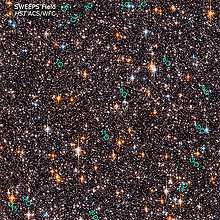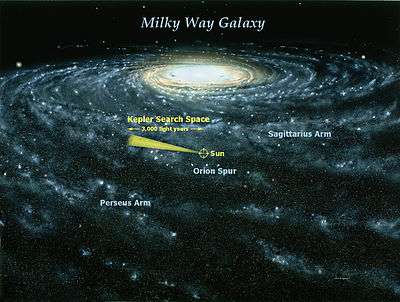Kilodegree Extremely Little Telescope
The Kilodegree Extremely Little Telescope (or KELT) is an astronomical observation system formed by two robotic telescopes that are conducting a survey for transiting exoplanets around bright stars. The project is jointly administered by members of The Ohio State University Department of Astronomy,[1] the Vanderbilt University Department of Physics and Astronomy[2] Astronomy Group,[3] the Lehigh University Department of Physics,[4] and the South African Astronomical Observatory (SAAO).[5]
| Alternative names | KELT |
|---|---|
| Survey type | astronomical observatory, astronomical survey, robotic telescope, optical telescope |
| Target | exoplanet |
KELT Telescopes
KELT consists of two telescopes, KELT-North[6] in Arizona in the United States, and KELT-South[7] at the SAAO observing station near Sutherland, South Africa.
Each KELT telescope consists of a wide field (26 degrees by 26 degrees) medium format telephoto lens with a 4.2 cm aperture, mounted in front of a 4k x 4k Apogee CCD. Each can also be equipped with an alternative narrower field (10.8 degrees by 10.8 degrees) lens with a 7.1 cm aperture for a narrow angle campaign mode. KELT-North uses an Apogee AP16E camera, while KELT South uses an Apogee U16M. The optical assemblies and cameras are mounted on Paramount ME[8] mounts manufactured by Software Bisque.[9]
KELT-North
KELT-North is located at Winer Observatory in southeastern Arizona, about an hour's drive from Tucson. KELT-North was installed at Winer in 2005, and has been operating continuously since then, with occasional interruptions for equipment failures and poor weather.
KELT-South
KELT-South is located at the Sutherland astronomical observation station owned and operated by SAAO, about 370 kilometers (230 mi) North of Cape Town. KELT-South was deployed at Sutherland in 2009.
Goals
KELT is dedicated to discovering transiting exoplanets orbiting stars in the apparent magnitude of 8 < V < 10 magnitude. This is the regime just fainter than the set of stars comprehensively surveyed for planets by the radial-velocity surveys, but brighter than those typically observed by most transit surveys.
Operations
Both KELT telescopes operate by sequentially observing a series of predefined fields around the sky all night, every night when the weather is good. All recordings are made with 150-second exposures, optimized to observe stars in the target magnitude range of KELT.
Exoplanet discoveries
KELT has made several exoplanet discoveries and at least one brown dwarf to date.
| Star | Constellation | Right ascension |
Declination | App. mag. |
Distance (ly) | Spectral type |
Planet | Mass (MJ) |
Radius (RJ) |
Density (g/cm3) |
Orbital period (d) |
Semimajor axis (AU) |
Orbital eccentricity |
Inclination (°) |
Discovery year |
|---|---|---|---|---|---|---|---|---|---|---|---|---|---|---|---|
| KELT-2A | Auriga | 06h 10m 39s | +30° 57′ 26″ | 8.77 | 420 | F7V | KELT-2Ab | 1.486 | 1.306 | 4.11379 | 0.05498 | 0.0 | 88.5 | 2012 | |
| KELT-3 | Leo | 09h 54m 34.0s | +30° 38′ 24″ | 9.8 | 580 | F6V | KELT-3b | 1.418 | 1.333 | 0.75 | 2.70339 | 0.04117 | 0.0 | 84.32 | 2012 |
| KELT-4A | Leo | 10h 28m 15.011s | +25° 34′ 23.5″ | 9.98 | 685 | F8V | KELT-4Ab | 0.878 | 1.706 | 2.9895933 | 0.04321 | 0.0 | 83.11 | 2015 | |
| KELT-6 | Coma Berenices | 13h 03m 56s | +30° 38′ 24″ | 10.38 | 724 | F9IV | KELT-6b | 0.43 | 1.19 | 0.311 | 7.84563 | 0.079 | 0.22 +0.12 −0.10 | 88.81 | 2013 |
| KELT-7 | Auriga | 05h 13m 11s | +33° 19′ 05″ | 8.54 | 420 | F2V | KELT-7b | 1.28 | 1.533 | 0.442 | 2.7347749 | 0.04415 | 0.0 | 83.76 | 2015 |
| KELT-8 | KELT-8b | 2015 | |||||||||||||
| KELT-9 | Cygnus | 20h 31m 27s | +39° 56′ 20″ | 7.56 | 620 | KELT-9b | 2015 | ||||||||
| KELT-10 | KELT-10b | 2015 | |||||||||||||
| KELT-14 | KELT-14b | 2015 | |||||||||||||
| KELT-15 | KELT-15b | 2015 | |||||||||||||
| KELT-16 | KELT-16b[10] | 2017 | |||||||||||||
| KELT-18 | KELT-18b[11] | 2017 |
In addition, the survey has discovered brown dwarfs like KELT-1b.
| Star | Constellation | Right ascension |
Declination | App. mag. |
Distance (ly) | Spectral type |
Planet | Mass (MJ) |
Radius (RJ) |
Density (g/cm3) |
Orbital period (d) |
Semimajor axis (AU) |
Orbital eccentricity |
Inclination (°) |
Discovery year |
|---|---|---|---|---|---|---|---|---|---|---|---|---|---|---|---|
| KELT-1 | Andromeda | 00h 01m 26.92s | +39° 23′ 01.7″ | 10.00 | 854 | F5V | KELT-1b | 27.23 | 1.110 | 1.217513 | 0.0247 | 0.0 | 87.80 | 2012 |
References
- "The Ohio State Department of Astronomy".
- "Vanderbilt Department of Physics and Astronomy". Archived from the original on 2012-06-16. Retrieved 2012-06-12.
- "Vanderbilt Astronomy Group".
- "The Lehigh Department of Physics".
- "South African Astronomical Observatory".
- Pepper, Joshua; et al. (2007). "The Kilodegree Extremely Little Telescope (KELT): A Small Robotic Telescope for Large-Area Synoptic Surveys". Publications of the Astronomical Society of the Pacific. 119 (858): 923–935. arXiv:0704.0460. Bibcode:2007PASP..119..923P. doi:10.1086/521836.
- Pepper; et al. (2012). "The KELT-South Telescope". Publications of the Astronomical Society of the Pacific. 124 (913): 230–241. arXiv:1202.1826. Bibcode:2012PASP..124..230P. doi:10.1086/665044.
- "Paramount ME". Archived from the original on 2012-07-02.
- "Software Bisque company page".
- Oberst, Thomas E.; Rodriguez, Joseph E.; Colón, Knicole D.; Angerhausen, Daniel; Bieryla, Allyson; Ngo, Henry; Stevens, Daniel J.; Stassun, Keivan G.; Gaudi, B. Scott; Pepper, Joshua; Penev, Kaloyan; Mawet, Dimitri; Latham, David W.; Heintz, Tyler M.; Osei, Baffour W.; Collins, Karen A.; Kielkopf, John F.; Visgaitis, Tiffany; Reed, Phillip A.; Escamilla, Alejandra; Yazdi, Sormeh; McLeod, Kim K.; Lunsford, Leanne T.; Spencer, Michelle; Joner, Michael D.; Gregorio, Joao; Gaillard, Clement; Matt, Kyle; Dumont, Mary Thea; et al. (2017). "KELT-16b: A Highly Irradiated, Ultra-short Period Hot Jupiter Nearing Tidal Disruption". The Astronomical Journal. 153 (3): 97. arXiv:1608.00618. Bibcode:2017AJ....153...97O. doi:10.3847/1538-3881/153/3/97.
- McLeod, Kim K.; Rodriguez, Joseph E.; Oelkers, Ryan J.; Collins, Karen A.; Bieryla, Allyson; Fulton, Benjamin J.; Stassun, Keivan G.; Gaudi, B. Scott; Penev, Kaloyan; Stevens, Daniel J.; Colón, Knicole D.; Pepper, Joshua; Narita, Norio; Tsuguru, Ryu; Fukui, Akihiko; Reed, Phillip A.; Tirrell, Bethany; Visgaitis, Tiffany; Kielkopf, John F.; Cohen, David H.; Jensen, Eric L. N.; Gregorio, Joao; Baştürk, Özgür; Oberst, Thomas E.; Melton, Casey; Kempton, Eliza M.-R.; Baldrige, Andrew; Zhao, Y. Sunny; Zambelli, Roberto; et al. (2017). "KELT-18b: Puffy Planet, Hot Host, Probably Perturbed". The Astronomical Journal. 153 (6): 263. arXiv:1702.01657. Bibcode:2017AJ....153..263M. doi:10.3847/1538-3881/aa6d5d.

